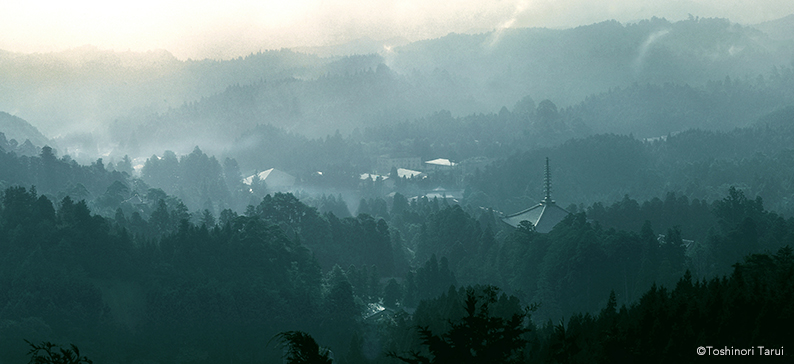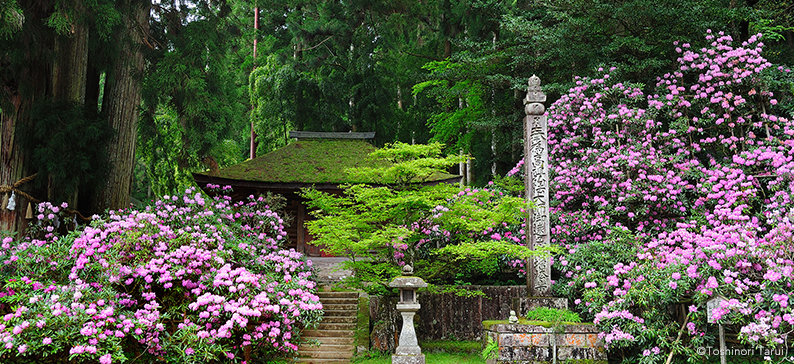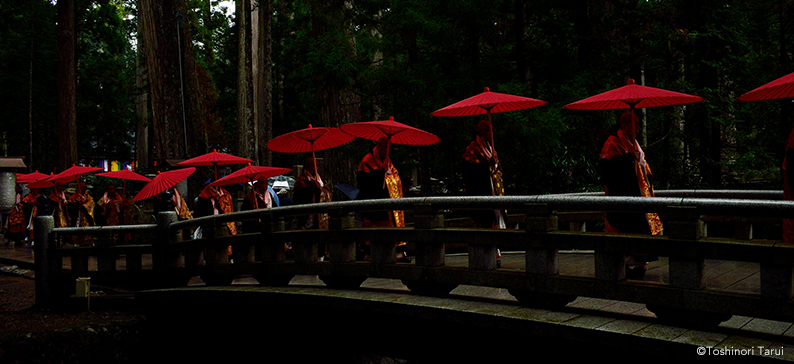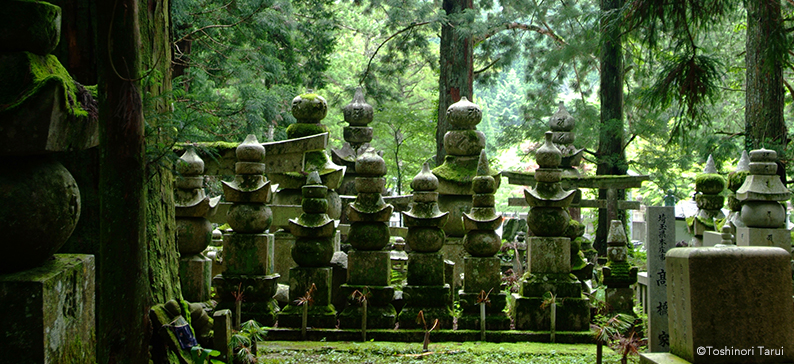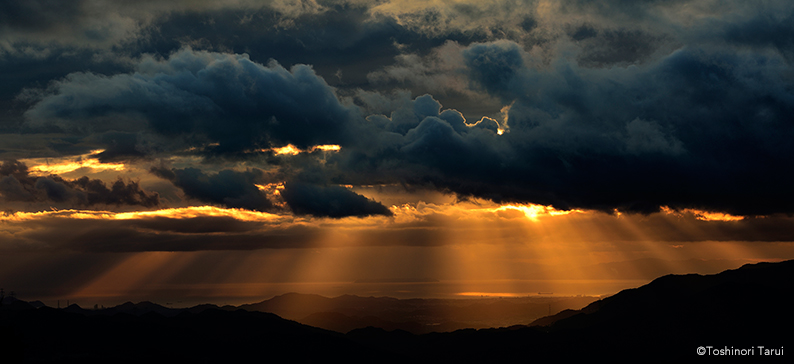Koyasan
Walking through the 1,200-year-old cemetary, time seems to stand still. Ancient Japanese cedars spiral towards the sky, inviting me to throw my arms around them.
KOYASAN
Temple Town in the Sky
After a five-hour trek from Tokyo that spanned 3 trains and a bus ride, I still haven’t arrived. Just where is this famed Koyasan? The red-and-white striped cable car, tilted on a sharp incline, lurches to a halt. I’ve finally arrived in Temple Town.
Nine hundred meters above sea level and surrounded by thick forest, the air is cool and pure. Walking from the cable car to the bus stop, I pick up on a this-is-not-your-ordinary-tourist-destination vibe. Despite being a UNESCO world heritage site, there’s something unusual about this place. The cable car station at the bottom was called Gokuraku-bashi (“Bridge of Paradise”) – maybe that has something to do with it.
The bus winds along a narrow mountain road, occasionally stopping to let oncoming cars pass. The town center, located at one of two traffic lights, is quaint with little shops and restaurants. As I wander the streets, I see a temple with lanterns hanging at both sides of the entrance. Hey, there’s another temple right next to it. And another. And another. In fact, the entire town seems to be awash with temples.
I stop by the tourist information center. How many temples are there in Koyasan? Over 100, says the man behind the counter. The population? 3,000. That’s quite the temple-to-people ratio. The man behind the counter says that’s nothing compared to the 2,700 temples Koyasan boasted in its heyday in the 15th century.
So what’s the deal with all these temples? Going back 1,200 years, a Buddhist master was on the lookout for a place to base his new spiritual practice. Deep in the mountains of Wakayama, he came across a large valley, where he decided to hang his straw sandals. The year was 816, and the Buddhist master was Kobo Daishi, who later became one of Japan’s most significant religious figures. Kobo Daishi was just back from a trip to China, where he’d learned something revolutionary.
Until then, the common belief in Japan was that you had to go through many cycles of birth and death before attaining enlightenment. But Kobo Daishi had learned that, through meditation and chanting mantras, anyone could attain enlightenment instantly in this life. And so, he founded the esoteric Shingon school of Buddhism in the mountaintop valley of Koyasan.
The lotus-shaped valley of Koyasan is surrounded by 8 peaks. Kobo Daishi saw it as the center of a lotus flower surrounded by 8 petals. Like a parabola receiving energy from the universe, Koyasan has continued to be a spiritual center for over 12 centuries.
As I muse on all this, I pass by some more temples and arrive at Okunoin, the site of Kobo Daishi‘s mausoleum. Walking over a bridge, I enter a forest. A magnificent forest, with A LOT tombstones. 200,000, to be exact. Walking along the two-kilometer approach to the mausoleum, time seems to stand still. Ancient Japanese cedars spiral towards the sky, each inviting me to throw my arms around them. I accept the invitation, and hear murmurs of history running through the heartwood. Some tree trunks have coins wedged in them; others have groups of apron-donned jizo statues, guardians of children, leaning against their base.
Members of the Imperial family, prominent monks, warlords, poets and commoners had their tombstones erected here in Okunoin, seeking salvation by being buried close to Kobo Daishi. The tombstones, geometric in shape and enwrapped in bright green moss, are lit by spots of sunlight who’ve found their way through the thick forest canopy. Occasionally, a monk wrapped in yellow robes walks by, with the sound of wooden clogs echoing off the tombstones. This place is so photogenic. I’ve taken hundreds of photos of tombstones, and haven’t even arrived at the mausoleum. I hold back the urge to take more photos and pick up my pace.
I come to the base of a bridge where people are queuing to splash water onto a bunch of Buddha statues. Without understanding why, I join in on the fun. After dowsing the deities and myself, I cross the bridge to finally arrive at KKobo Daishi‘s mausoleum, and pay tribute to the Grand Master.
According to legend, Kobo Daishi announced the moment of his imminent death. He stopped taking food and water, and spent his final moments in meditation. At that precise date and time, he fell into deep meditation. Believing that he still continues to meditate today, monks have been providing food for him twice a day for over 1,000 years. Kobo Daishi also announced that he would awaken in 567 million years’ time, when he would no longer need to pray for world peace. In 567 million years’ time, there might not be much that we need to pray for.
Leaving the mausoleum, I decide to walk through the more modern part of Okunoin. Okay, so I might be in a bit of a daze, but I’m seeing stone sculptures of coffee cups on saucers. Rockets. Blowfish. Panasonic. A termite extermination company. What the hay? Are these tombstones, too? Yes, according to the Japanese tourist I accost. They were offered to repose souls, she says. I guess we’re talking about the souls of employees who perished on the job, as well as those of termites whose lives were sacrificed, and rockets that went astray. But coffee cups on saucers?
I’m exhausted after spending hours in a tombstone-filled forest contemplating unanswerable questions, and decide to stay for the night in Koyasan. Back at the tourism office, I ask the same man who told me about the temple-people ratio, if he can recommend somewhere to stay. He gives me several choices of…temples. To stay overnight in Koyasan, you pretty much have to stay in a temple, and eat and sleep like a monk. How original. And how Koyasan. Might as well soak up the monk experience from head to toe. More about that experience here.
I ask the man at the tourism office (which I find out is actually the Temple Lodging Office) if he knows of any nice hikes I can do around here. Glancing at my Gore-Tex boots, he tells me of a hike along a historic path. That sounds nice. How do I get there? Take the cable car down part way and walk up the path that Kobo Daishi originally took. Are you kidding? That cable car came up a pretty impossible incline. There’s a reason it’s attached to a cable.
Before the advent of the cable car though, people used to walk for months from all over Japan to enter Koyasan, an act they referred to as “entering the mountain.” And they didn’t have Gore-Tex boots, only straw sandals. They came to be trained as monks, to pay tribute to Kobo Daishi, or simply to pray for a loved one. They were – pilgrims. And the entire town was dedicated to prayer. Not so many of us visitors today are as religious or pious.
Suddenly, I remember the feeling I had when I first arrived. The story of Kobo Daishi still meditating for world peace is out there. But maybe, somewhere deep down, we feel the urge to believe in something. Maybe we’re on a different kind of pilgrimage. One where we don’t quite know where we’re headed. At the very least, we could all use the serenity and oxygen Koyasan has to offer.
There IS something special in the air here. Maybe I WILL go on that hike tomorrow. After all, I’m a modern day pilgrim.
Special thanks
Photographer: Toshinori Tarui
As a contract photographer for Fuji Film, Toshinori first received a request from the Nankai Electric Railway to photograph Koyasan in 1974. Fascinated by the depth of Shingon Buddhism and its environment, Toshinori became enamored with the mystic temple town embedded deep in the mountains.
Photographing Koyasan and its harsh environment for over 40 years, Toshinori was confronted with severe weather, anxiety and loneliness.
This experience transformed him from a commercial photographer into a landscape photographer with a purpose: to *transmit* the mystery and beauty of Koyasan. His work is a culmination of his life as a photographer.
http://fujiphotohouse.jp/works/toshinori/
http://kouyasiki.sakura.ne.jp/
by Maho Harada
July 15, 2016
Koyasan information
- TOPCOLUMNKoyasan
- TOPDESTINATIONSKOYASANKoyasan







